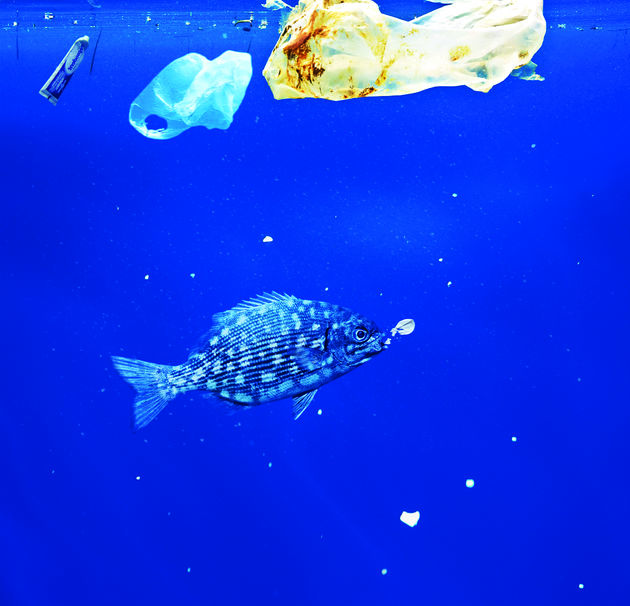 Image by Paulo Oliveira/Alamy
Image by Paulo Oliveira/Alamy
David Attenborough and the BBC hadn’t planned to cover plastic pollution but the reality was too shocking to ignore, finds Richard Gray
Around ten years ago, a conversation I was having with a marine scientist about exploring the deep seas of the Arctic took an unexpected turn. While searching for marine life more than 2,000m beneath the surface with a submersible vehicle, instead what he found was a plastic shopping bag.
At the time, relatively few people seemed to care. The story I wrote never made it onto the pages of the newspaper I worked for. But fast forward to 2019, and plastic pollution is regarded as one of the most important environmental crises facing our planet. Public campaigns have forced manufacturers to replace long-lasting disposable plastics with biodegradable alternatives. New rules on plastic recycling are being introduced around the world and single-use plastic bags are being taxed or banned outright in many countries.
Much of this enormous recent shift in public and political opinion can be credited to a single television series. In Blue Planet II, the BBC’s Natural History Unit brought its formidable visual and storytelling power to bear on the plastics problem. The series told many unique and striking stories of the wildlife that inhabits the Earth’s oceans, but in the final episode – titled Our Blue Planet – the team focused on the effect that we are all having on the marine environment.
This episode highlighted a range of problems, from overfishing to climate change, but it was the plastic pollution accumulating in the sea that captured the public imagination. It is hard to forget Sir David Attenborough stood on a windswept beach, brandishing a discarded drink bottle in one hand and a fistful of assorted plastic debris in the other, delivering a devastating warning about the harm our 100-year-long addiction to this wonder material is having. It was moving to witness the plight of wandering albatross chicks killed by plastic litter, after their parents mistakenly snatched it from the water and regurgitated it into the mouths of their waiting young.
It is perhaps surprising, then, to learn that when the series was first commissioned, the producers had not planned to feature plastics. This changed during the four years of filming, when crews were shocked by events they captured on camera – such as a baby sperm whale trying to gulp down a plastic bucket and sea turtles entangled in polybags and nylon netting.
In the past, the BBC Natural History Unit’s flagship productions have tended to shy away from overtly showing the impact humanity is having on the planet, instead focusing on animals in wild settings seemingly separate from their human neighbours. With UN reports warning that urgent action is needed to halt disastrous climate change and more than a million species now threatened with extinction due to human activities, the BBC and Attenborough seem to have chosen to confront the problems they encountered while filming Blue Planet II head on.
They did this with an approach the Natural History Unit now excels in: by finding stories that would resonate with audiences. They focused on the plight of individual animals that the viewer could connect with. They showed pieces of plastic and debris that were easily recognisable and most people have in their homes – toothpicks, plastic lighters, gloves, the wrapper from a bag of rice. It made people angry. Not just with distant others who were dumping this stuff, but with themselves too. Everyone was culpable.
Even the series’ producers admit they were not quite expecting the response it received. In the UK, Blue Planet II was the most watched TV series of 2017, but it has also been exported to 30 other countries around the world and watched by 750 million people. The scenes depicted in the series, together with the warnings in the final episode that were delivered carefully and precisely on screen by scientists who were witnessing the problem first hand, appeared to jolt the public awake, triggering a powerful, visceral reaction among viewers that has reverberated around the world.
The so-called ‘Blue Planet effect’ inspired people to go out onto beaches to pick up the manmade debris they found. Young children in schools asked to stop using plastic straws and most of us now carry a reusable water bottle. Even the Queen is reported to have banned plastic bottles and straws on the Royal Estates in response to the programme.
Major multinational companies have pledged to reduce single-use plastics in their products and improve recycling of their packaging. Governments around the world also took action. A bill is currently before the UK parliament that aims to set targets for reducing plastic pollution, while the European parliament has voted to ban single-use plastics by 2021. Theresa May even presented Chinese president Xi Jinping with a box set of Blue Planet II, signed by Attenborough, during his visit to the UK in 2018, as a symbol of a joint plan the two countries drew up to tackle plastic pollution.
The response led the BBC itself to take the unusual step of launching its own campaign to tackle the 8 million tonnes of plastic that are dumped into the oceans every year. Attenborough delivered YouTube messages and gave interviews about the unfolding plastic pollution ‘catastrophe’. Blue Planet II has gone far beyond the goals of most television programmes to provide entertainment. It has convinced people they can change the world.



















